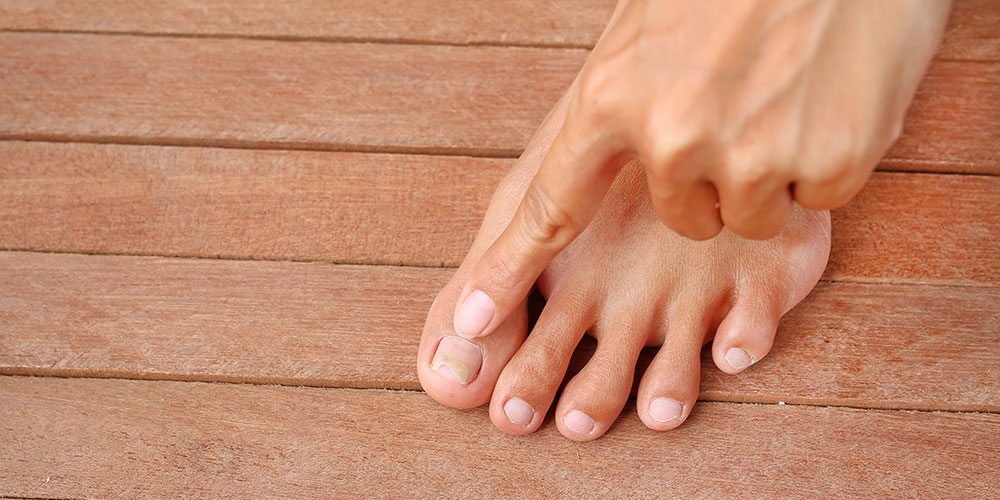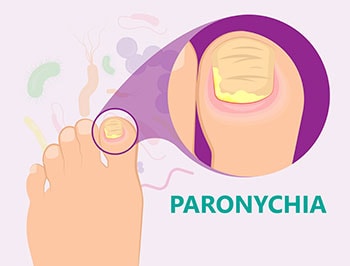
Paronychia is almost as annoying to pronounce as it is to have. This troublesome infection of the fingernails and/or toenails is more common in women than men, and workers who spend long portions of their day with their feet submerged in water are also more likely to develop it.
But what exactly is a paronychia toe infection? What causes it? And what can we do to treat it?
What is paronychia
Paronychia is an infection of the skin around a finger or toenail and is one of the most common hand infections in the US. It can be caused by a yeast (Candida) or bacterial infection and is generally a result of injury to the cuticle or nail fold (the skin around the nail plate). The cuticle and lateral nail folds are important barriers between the nail and surrounding tissue.
Injury to these protective barriers allow pathogens to get into the nail, causing infection. Sometimes, yeast and bacteria (the most common being Staphylococcus aureus) will both infect the nailbed.
The two types of paronychia are:
Acute Paronychia
An acute infection develops quickly. Picking hangnails, biting nails, manicures and pedicures, aggressively pushing down cuticles, or other traumas to the nail create an entry for bacteria or yeast.
Chronic Paronychia
A chronic infection comes on more slowly, can last for several weeks, and often comes back. It typically consists of multiple infecting agents. Chronic paronychia is more common in people who’re constantly working in water and is often caused by contact dermatitis. Excessive soaking of the skin disrupts the natural barrier of the cuticle, allowing yeast and bacteria to get underneath and grow.
Paronychia diagnosis
Generally, a health care professional can diagnose paronychia by observing the affected toe.
Your podiatrist or dermatologist may take a sample of the paronychia pus (if present) from the infection. A biopsy on this pus can determine the exact infection and allow your doctor to prescribe the best treatment.
If you think you may have paronychia, you should see a healthcare professional for diagnosis as there are other dermatologic conditions that have similar symptoms:
- Psoriasis – causes thickening and pitting of the nail
- Herpetic Whitlow– forms tiny pustules, but is not usually located along the nail edge
- Onychomycosis – a fungal infection under the nail
Paronychia Symptoms

The symptoms of acute and chronic paronychia are very similar. Common symptoms include:
- redness or tenderness of the skin around the nail
- pus-filled blisters
- changes in nail shape, color, or texture
- detachment of the nail
If you think you have fungal or bacterial paronychia, contact a doctor for medical advice before attempting paronychia home treatment.
Furthermore, if you have any of the following more extreme symptoms call your healthcare provider right away:
- redness, pain, or swelling gets worse
- trouble moving or bending the toe
- red streaks in the skin leading away from the wound
- pus or fluid draining from the infected nail
- fever of 100.4ºF or higher
Paronychia Treatment Options
Treatment options will depend on the specifics of the nail infection. For acute paronychia, topical or oral antibiotics may be prescribed to fight the infection. If the infection has not yet formed an abscess, warm water compresses and soaking the infected nail in vinegar may be effective.
For a fungal toenail infection, an antifungal and/or corticosteroid lotion will most likely be prescribed.
If addressed early, paronychia can be effectively treated and the nail preserved.
For stubborn chronic paronychia, excision of the proximal nail fold (where the skin meets the base of the nail) is a treatment option.
How to treat paronychia at home
After consulting with a medical professional, you may be able to treat mild acute paronychia at home.
If pus has collected under the skin, soak the infected area in warm water several times a day, drying thoroughly afterward.
Do not attempt to pierce or drain lesions around the nail on your own. Your doctor can drain any blisters or abscesses to relieve discomfort and avoid spreading the infection.
For chronic paronychia, home treatment isn’t likely to work. You’ll need to see your doctor for treatment.
The important part of home treatment is using any antibiotics or antifungals prescribed by your doctor.
How to avoid nail infection
As they say, “an ounce of prevention is worth a pound of cure.” The best way to treat paronychia is to never get it in the first place. Good hygiene is the first step of infection prevention.
- Avoid trauma to the nail caused by picking at the nail, stubbed toes (trauma to the toenail can cause break), and pedicures.
- Cut your toenails straight across to avoid ingrown nails. Ingrown toenails create openings for bacteria to get under the skin.
- Avoid contact with irritants such as harsh, cleaning chemicals.
- If you are constantly submerging your hands or feet in water, wear rubber gloves or waterproof shoes when possible. Keeping the skin around the nails dry can help prevent chronic paronychia.
Why choose University Foot and Ankle for your nail care?
If you’re experiencing a toenail infection or have an ingrown toenail that could lead to infection, we’re here to help. Our nationally recognized foot and ankle specialists offer the most advanced podiatric care and the highest success rates in the nation. We are leaders in researching, diagnosing, and treating all foot and ankle conditions.
At University Foot and Ankle Institute, we take our patients’ safety seriously. Our facility’s Covid-19 patient safety procedures exceed all CDC recommendations.
For more information or to schedule a consultation in the greater Los Angeles area, please call (877) 736-6001 or make an appointment now.
University Foot and Ankle Institute is conveniently located throughout Southern California and the Los Angeles area as our foot doctors are available at locations in or near Santa Monica, Beverly Hills, West Los Angeles, Manhattan Beach, Northridge, Downtown Los Angeles, Westlake Village, Granada Hills, and Valencia, California.
- If the Shoe Fits, Wear it… Especially for Kids Shoes! - September 4, 2023
- Is Barefoot Running Better? Or are you Running Toward Injury? - August 18, 2023
- 15 Summer Foot Care Tips to Put Your Best Feet Forward - August 8, 2023